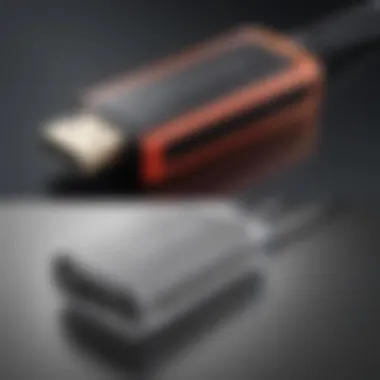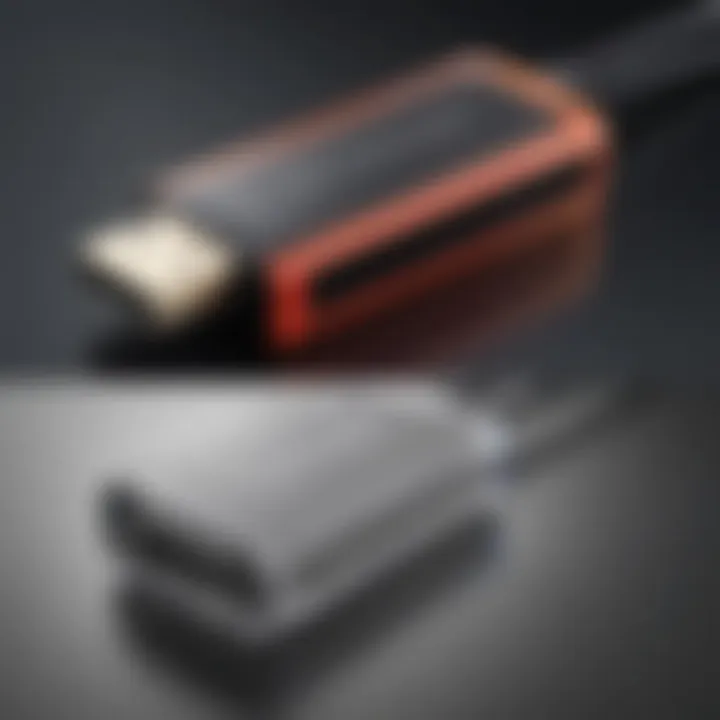Understanding USB PD Adapters: A Comprehensive Guide


Intro
USB Power Delivery (USB PD) adapters have become a staple in the modern technological ecosystem. Their efficiency in charging devices like smartphones, tablets, and laptops at impressive speeds makes them invaluable. With each new generation of devices requiring more power for functionality, understanding the intricacies of USB PD adapters becomes necessary. This article will delve into their features, benefits, and compatibility, and highlight the current technological advancements in this field. By unpacking these elements, readers will be better equipped to navigate the options available in the market.
Overview of USB PD Adapters
Functionality of USB PD Adapters
USB PD adapters utilize a protocol that allows for higher power transfer through USB connections. This means you can charge more powerful devices much faster than typical USB chargers. For instance, while standard USB chargers may deliver up to 2.5 watts, USB PD can handle up to 100 watts. This capability is particularly beneficial for devices like laptops that often require a higher charge.
Benefits of Using USB PD Adapters
- Faster Charging: USB PD adapters significantly reduce charging time for compatible devices.
- Higher Power Transfer: As mentioned, they can provide up to 100 watts, enabling charging of more demanding devices.
- Universal Compatibility: Many devices are now built to support the USB PD standard, making these adapters versatile.
- Safety Features: Numerous USB PD adapters feature built-in safety mechanisms to prevent overcharging and overheating.
Compatibility Issues
Despite their advantages, compatibility can pose a challenge. Here are some points to consider:
- Device Support: Not all devices support USB PD, so checking compatibility is essential before purchasing.
- Cables and Connectors: Using the correct cable is crucial, as lower quality or mismatched cables can hinder performance.
Latest Advancements in USB PD Technology
The development of USB PD technology continues to advance. Newer configurations include power banks, car chargers, and even wall outlets that support the protocol. Some of these devices can negotiate power delivery to optimize charging based on the connected device’s requirements.
"Understanding the advancements in USB PD technology informs users on how to better utilize their devices and maximize charging efficiency."
As the landscape of charging technology evolves, USB PD remains at the forefront, shaping the future of how we power our devices. With continued improvements and increased adoption across various electronics, knowledge of USB PD adapters becomes not only beneficial but essential to modern device usage.
Intro to USB PD Adapters
Understanding USB Power Delivery (PD) adapters is crucial in today’s technology-driven landscape. These devices represent a significant advancement in charging methods, offering not only faster charging but also greater versatility. For avid smartphone users and tech enthusiasts, the implications of adopting USB PD technology carry substantial weight, especially considering the rapid evolution of electronic devices and their power needs.
In this section, we will delve into the definition and function of USB PD adapters, shedding light on their operational mechanisms and their role in the contemporary ecosystem of digital gadgets. Additionally, we will explore the historical context of USB technology, framing the evolution of the USB PD standard in relation to earlier protocols. Understanding this background equips users with insights into how USB PD adapters improve user experience and enhance device performance.
Definition and Basic Function
USB Power Delivery (PD) adapters serve as a means to deliver higher power levels through USB connections. Unlike traditional USB chargers, which usually offer limited power outputs to devices, USB PD can provide up to 100 watts of power. This capability allows for not just charging smartphones but also laptops and other power-hungry devices.
The basic function of a USB PD adapter involves negotiation between the power source and the receiving device. Upon connection, both devices communicate through the USB protocol, ensuring that the receiving device gets the appropriate amount of power based on its requirements. This negotiation is dynamic, meaning that it can adjust power levels depending on the device’s current needs, which is a significant improvement over older charging technologies.
Historical Context of USB Technology
The journey of USB technology began in the mid-1990s. The intent was to create a standard for connecting peripherals to computers. Initially, USB 1.0 emerged with transfer speeds of 1.5 Mbps. Over time, subsequent versions such as USB 2.0 and USB 3.0 followed, improving speed and enhancing functionality. However, it wasn't until the introduction of USB Power Delivery in 2012 that the potential for higher power distribution began to surface.
USB PD was developed in response to the growing necessity for efficient charging methods, particularly as portable devices expanded in capability and power consumption. By standardizing power delivery through USB connections, it enabled manufacturers to streamline charging protocols across different types of devices. This historical development set the stage for the widespread adoption of USB PD adapters, marking a pivotal shift in how we think about device charging today.
In summary, USB PD adapters are not just another charging tool; they represent crucial progress in device connectivity and energy efficiency. Understanding their definition, function, and historical significance offers a comprehensive view of their importance in current technology.
Understanding Power Delivery Standards
Understanding Power Delivery standards is crucial for optimizing the usage of USB PD adapters. These standards govern how power delivery is negotiated between devices, determining the amount of power that can be transferred. The efficacy of USB PD standards directly impacts charging speed and efficiency, making it imperative for users to comprehend its implications.
The Evolution of USB Power Delivery
The evolution of USB Power Delivery started with the introduction of USB 3.0, which aimed to enable faster data transfer. However, it was not until USB Power Delivery 2.0 that the ability to deliver higher power levels became possible. This version allowed devices to negotiate power levels up to 100 watts, catering to a wider range of electronics, including laptops and other high-power devices.
The release of USB PD 3.0 introduced further enhancements, such as programmable power supply (PPS) capabilities. PPS allows for more precise power management, adjusting voltage and current dynamically. This ensures that devices receive the optimal charge, thereby increasing energy efficiency.
The progression from basic power delivery to a more sophisticated exchange has enabled a more robust ecosystem of USB-powered devices. The developments in this standard highlight the industry's commitment to improving user experience with faster, smarter, and more efficient charging solutions.


Comparison between USB PD and Other Charging Standards
USB Power Delivery can be compared to various other charging standards, notably Qualcomm’s Quick Charge and Apple's Lightning. While Quick Charge generally focuses on smartphones and smaller devices, it lacks the universal compatibility offered by USB PD. Essentially, USB PD's adaptability allows it to function across multiple device categories, which can be appealing to many consumers.
Apple's Lightning connector offers a proprietary charging standard. It can provide quick charging but is limited to Apple's devices, making it less versatile compared to USB PD. In contrast, USB PD supports a broader range of devices including tablets, laptops, and more, facilitating an integrated charging solution for various electronics.
In summary, the comparison reveals USB PD as a forward-thinking standard that prioritizes versatility across devices, tackling common limitations found in other charging methods. This adaptability in USB PD ultimately ensures a seamless user experience and enhances interoperability in the growing landscape of electronic devices.
Components of a USB PD Adapter
Understanding the components of a USB PD Adapter is vital for grasping how these devices function effectively. Each part plays a specific role in ensuring efficient power delivery, adaptability, and safety. Without knowledge of these components, users may struggle to select the right adapter or troubleshoot issues effectively.
Physical Design Considerations
When it comes to the physical design of a USB PD adapter, several factors should be taken into account. First, the size and portability of an adapter can greatly influence user convenience. Smaller adapters might be more appealing for travelers, but they should maintain robust functionality, including adequate power capacity.
Another significant aspect is the material used. Quality materials enhance durability and ensure that the adapter reliably withstands daily use. For example, many adapters feature a plastic exterior for lightweight traveling, while others use metal for better heat dissipation.
Finally, the connector type also matters. USB-C connectors are favored for their reversible nature and ability to support higher power levels. It is crucial that users check the compatibility of their devices with the connector type provided by the adapter.
Internal Technological Framework
The internal technological framework of USB PD adapters is complex but essential for their functionality. At the core is the power management circuit. This circuit enables the adapter to negotiate power requirements with connected devices. It dynamically adjusts the voltage and current according to the device's needs, optimizing charging time.
Additionally, many USB PD adapters include microcontrollers that manage the data exchanged between devices. These microcontrollers ensure that the power is safely regulated, maintaining the integrity of both the adapter and the device.
The incorporation of safety features is also critical. Technologies, such as overcurrent protection and thermal sensing, help to prevent damage during charging. If the adapter detects abnormal conditions, it can halt the charging process, safeguarding both the adapter and the electronic device.
In essence, a robust internal framework is crucial for ensuring the efficiency, safety, and adaptability of USB PD adapters in varied environments.
Charging Capabilities of USB PD Adapters
The charging capabilities of USB PD adapters are vital for understanding how these devices enhance the user experience. They not only provide power efficiency but also accelerate the charging process for a variety of devices. As technology progresses, the need for faster charging has risen significantly, making this aspect crucial for any modern adapter. The capacity to deliver higher power levels is a characteristic feature of USB PD adapters that sets them apart from traditional options.
This section will discuss two main elements regarding charging capabilities: the charging speed and the compatibility with various devices.
Charging Speed: What to Expect
When discussing charging speeds, it is important to recognize the potential of USB Power Delivery. USB PD allows for power transfer rates up to 100 watts, which is more than sufficient for charging laptops, tablets, and smartphones.
Typically, standard USB chargers might offer speeds around 5 to 12 watts, but with USB PD, that number can increase immensely. For instance, devices may achieve charging rates of 18 watts, 30 watts, or even 60 watts when connected to a compatible USB PD charger. This significant boost in power can drastically reduce the time needed to charge devices.
The exact speed one can expect, however, depends on several factors, including:
- Device compatibility: Not all devices can take full advantage of the higher wattage offered by USB PD.
- Cable quality: The cable must support high power transfer; otherwise, charging speeds can be limited.
- Power output of the adapter: The adapter itself needs to be able to deliver the desired wattage.
Generally, users can expect dramatic improvements in charging times, especially with higher-end devices designed to use USB PD technology. This is a key selling point that can influence consumer choices when selecting adapters.
Compatibility with Various Devices
USB PD adapters showcase a remarkable versatility when it comes to compatibility, which contributes to their widespread appeal. They are designed to work seamlessly with a range of modern electronic devices. This versatility is a major advantage, allowing users to charge not just one type of device but many.
Common devices compatible with USB PD adapters include:
- Smartphones: Nearly all recent models support USB PD, enabling faster charging.
- Laptops: Many ultrabooks and MacBooks use USB PD for quicker charging.
- Tablets: Devices like iPads have adapted to USB PD standards for efficient power delivery.
- Wearables: Some smartwatches and fitness trackers also utilize this charging technology.
However, while many devices are compatible, it's critical to check for specific support for the USB PD standard. Not all devices can utilize the maximum output, and knowing the requirements can prevent frustration.
"USB PD adapters represent a pivotal shift in charging technology, enhancing speed and compatibility across a vast list of devices. Investing in a quality USB PD adapter ensures optimal charging for modern electronic needs."
Overall, the charging capabilities of USB PD adapters are essential elements that users should consider. They provide not only faster charging but also extensive compatibility with various devices. As technology advances, awareness of these features becomes increasingly important for choosing the right charging solutions.


Benefits of Using USB PD Adapters
USB Power Delivery (PD) adapters have transformed the way we charge devices. Understanding their benefits is crucial for anyone who frequently uses technology. This section highlights the main advantages of USB PD adapters, focusing on energy efficiency and device versatility. These factors play a significant role in enhancing user experience and optimizing device performance.
Efficiency in Energy Use
One of the standout features of USB PD adapters is their efficiency in energy use. Unlike traditional chargers that often deliver a fixed amount of power, USB PD technology dynamically adjusts power delivery based on the needs of the connected device. This means that energy consumption is more aligned with what the device requires, leading to less waste.
- Smart Power Distribution: USB PD can sense how much power a device needs and supply exact levels accordingly. This avoids overcharging, which can waste energy and hurt the battery lifespan.
- Maximized Charging Speeds: Through higher power levels, USB PD can significantly reduce charging time. For instance, some laptops can draw up to 100W, allowing for a full charge in a much shorter time compared to conventional methods.
- Lower Heat Generation: Because of its ability to regulate energy flow, USB PD also minimizes heat production during charging. Lower heat results in better component longevity and safer charging experiences.
"USB PD technology reduces energy waste by aligning production with device needs, contributing to a sustainable future for tech users."
Versatility Across Devices
USB PD adapters are compatible with a multitude of devices, making them an ideal choice for those looking for versatility across devices. The adaptability of USB PD technology allows users to charge smartphones, tablets, laptops, and even some home appliances with a single adapter.
- Universal Compatibility: USB PD is not restricted to specific brands or device types. If a device has a USB-C port, it can potentially work with a USB PD charger, making it easy to consolidate charging solutions.
- Convenient for Multi-device Households: Many users now own multiple gadgets. Using a single USB PD adapter simplifies the charging process when juggling between devices like phones, tablets, and laptops.
- Future-proofing: As newer devices continue to adopt USB PD standards, investing in a USB PD adapter now ensures that you will remain compatible with future technology.
By understanding these benefits, users can make informed decisions about their charging needs and device management. USB PD adapters stand out not just for their efficiency but also for their flexibility in catering to a wide array of devices.
Safety Features in USB PD Technology
In the context of USB PD adapters, safety features hold significant importance. As these devices become integral for charging a wide array of electronics, understanding their safety mechanisms is paramount. The need for reliable safety protocols increases with the rising power capabilities provided by USB Power Delivery. Users must recognize that while these adapters enhance convenience and efficiency, they also present risks without proper safety measures. This section elucidates the mechanisms in place to ensure safe operation and to avert common risks associated with charging electronic devices.
Built-in Safety Mechanisms
USB PD adapters are equipped with several built-in safety mechanisms that ensure safe charging. These mechanisms primarily focus on heat management, current regulation, and voltage control.
- Heat Management: USB PD adapters generate heat during operation. To combat overheating, many adapters utilize thermal protection features. These features can interrupt power delivery when temperatures rise above safe limits, ensuring that both the adapter and the connected device aren’t damaged.
- Current Regulation: Another critical safety feature is current regulation. USB PD adapters adjust the amount of current supplied to the device based on its requirements. If a connected device tries to draw too much power, the adapter reduces the current to prevent overheating or potential damage.
- Voltage Control: The right voltage is crucial for effective device operation. A malfunctioning adapter could supply excessive voltage, damaging the connected device. USB PD technology includes voltage protection that guarantees voltage levels remain within safe operating limits.
These mechanisms work together to enhance the overall safety of USB PD adapters, making them reliable for everyday use.
Understanding Overcharge Protection
Overcharge protection is a fundamental aspect of USB PD technology, primarily designed to prevent battery damage. Lithium-ion batteries, commonly used in smartphones and laptops, have specific charging requirements. Without proper management, batteries can overheat or swell, leading to permanent damage or even hazardous situations.
- Intelligent Charging: Many USB PD adapters are equipped with intelligent charging algorithms. These algorithms determine the optimal charging cycle for each device. Once a device reaches full charge, the adapter automatically reduces power output or stops charging altogether.
- Regular Monitoring: Monitoring battery conditions in real-time is another way overcharge protection is ensured. These adapters continuously assess battery temperature and voltage levels to decide if continued charging is safe.
- Indicator Lights: Some USB PD adapters include indicator lights that inform users about the charging status. This can help users remain aware if a device is nearing full charge and thus should be disconnected.
The implementation of these safety features in USB PD technology highlights the commitment to enhancing device charging security while maintaining efficiency and user convenience.
Overall, understanding safety features and overcharge protection mechanisms is essential for any user looking to utilize USB PD adapters effectively. Proper knowledge enables users to select the right product and use it without fear of compromising their devices.
Selecting the Right USB PD Adapter
Choosing the appropriate USB PD adapter is crucial in ensuring your devices receive optimal charging. As technology advances, different devices require varying wattage and charging speeds. A mismatched adapter can lead to incompatible performance or even damage. This section discusses the key factors to consider when selecting a USB PD adapter, along with common misconceptions surrounding these devices.
Key Factors to Consider
Selecting the right USB PD adapter involves evaluating several important criteria:
- Power Output: The first point is understanding the required power output for your devices. Some laptops may need 65W while smartphones typically use 18W to 30W. An adapter with higher wattage can power more devices, but too much output does not mean that devices will overcharge, as they will only draw what they need.
- Port Type: Examine the port type. USB-C is the standard for USB PD charging. Ensure that your adapter has a USB-C output to maintain compatibility with modern devices. Older ports, like USB-A, will not support fast charging in the same manner.
- Cable Quality: The cable connecting the adapter to the device also affects the charging experience. Using a high-quality USB-C cable that supports USB PD is essential to leverage the full advantages of power delivery. Cheap cables often have limitations that can hinder performance.
- Brand Reputation: Consider reputable brands like Anker, Aukey, or Apple for their reliable and safe products. Quality brands typically offer better safety features and support.
- Safety Features: Safety is paramount. Look for adapters with built-in protections against overcurrent, overvoltage, and short circuits. This can prevent damage to your devices and should be a non-negotiable part of your selection process.
Ensuring that each of these factors is assessed can greatly enhance the performance and safety of your device charging.
Common Misconceptions
Some misconceptions persist when it comes to USB PD adapters. Addressing these can help clarify their function and capabilities:
- All USB-C Chargers Are the Same: Many believe that all USB-C chargers provide the same performance. In reality, the output varies by design. Not every USB-C charger supports power delivery, and even those that do can differ significantly in wattage.
- Higher Price Equals Better Quality: While it is true that some high-priced adapters offer advanced features, not every expensive model guarantees better performance. Research and user reviews are crucial for making an informed decision.
- Using an Adapter for Lower Wattage Devices is Unsafe: Some think it’s unsafe to use a higher wattage adapter for lower wattage devices. This is false. Devices will only draw the power they need from the adapter. Therefore, using an adapter with a higher wattage is safe and often more efficient.


"Understanding the essential characteristics of USB PD adapters can significantly impact the performance of your devices."
- All Charging Cables Support USB PD: This common belief can lead to underperformance when charging. Ensure that the cable used supports USB PD to achieve the expected charging speeds.
Debunking these misconceptions allows users to make better choices when investing in USB PD adapters, ultimately leading to a more satisfactory user experience.
The Future of USB PD Technology
The future of USB Power Delivery (PD) technology is a significant topic in this article as it influences the trajectory of device charging and power management. With the increasing number of devices requiring efficient charging solutions, USB PD continues to evolve. This section will delve into key elements shaping the future of USB PD, including emerging trends, innovations, and the potential for widespread adoption.
Emerging Trends and Innovations
USB PD technology is witnessing several trends that may redefine how we understand charging. One of these trends is the integration of higher power outputs. Early USB PD versions supported power flow up to 100 watts. Future iterations may increase capacity even more, catering for power-hungry devices such as laptops and gaming consoles. This capability facilitates faster charging and aids in managing energy consumption effectively.
Additionally, smart charging technology is emerging. This involves adapters that can communicate with devices to determine optimal charging rates, thus improving overall efficiency. Innovations, such as bi-directional charging, allow devices to share power. For instance, your smartphone can charge a tablet or other peripherals, enhancing the functionality of USB PD.
Another noteworthy innovation is the expansion of supported protocols. USB PD now interfaces with protocols like Quick Charge and Power Delivery 3.0, consolidating multiple charging methods into a unified system. This evolution increases flexibility for consumers, as they can use a single charger for various devices.
Potential for Widespread Adoption
The potential for widespread adoption of USB PD technology is high. As devices become more interconnected and reliant on optimal charging solutions, consumers are recognizing the necessity of USB PD adapters. Industry leaders and manufacturers are beginning to standardize USB PD in their products. This trend indicates a shift towards universal charging standards, reducing e-waste and confusion around compatibility.
Moreover, as the Internet of Things (IoT) gains traction, USB PD will be critical. Smart home devices, wearables, and other IoT gadgets will require efficient power delivery systems. USB PD can meet these demands, providing versatility across the product ecosystem.
Common Issues with USB PD Adapters
USB Power Delivery (USB PD) adapters offer significant benefits, yet users may encounter several common challenges that can hinder their optimal use. Understanding these issues is crucial for anyone relying on USB PD technology. Not only does it help in efficient troubleshooting, but it also enhances the overall user experience. An informed user can minimize downtime, ensuring devices stay powered without unnecessary interruptions.
Compatibility Problems
One of the most prevalent issues with USB PD adapters is compatibility. Though USB PD is designed to be universal, this does not mean that every adapter will work seamlessly with every device. Different manufacturers often implement USB PD specifications with variations, leading to inconsistent results. As a user, it’s essential to confirm that both the adapter and the device support the same USB PD version.
Here are a few points to consider regarding compatibility:
- Device Specifications: Check if your device supports the required charging voltage and current output.
- Cable Quality: Sometimes, the charging cable may not meet the specifications required for USB PD. Using a low-quality or incompatible cable can cause charging issues.
- Firmware Updates: Check if there are firmware updates for devices that could enhance compatibility with USB PD adapters.
- Brand Restrictions: Certain brands may limit compatibility to their own products, leading users to experience charging failures.
Troubleshooting Charging Issues
When charging issues arise, knowing how to troubleshoot effectively can save frustration. Common symptoms may include device not charging, slow charging rates, or overheating. Addressing these issues can often be achieved through simple checks.
To troubleshoot, follow these steps:
- Inspect the Adapter and Cables: Look for any physical damages. Frayed wires or worn-out connectors can lead to faulty connections.
- Test with Different Devices: If possible, try using the adapter with other devices to determine if the issue lies with the adapter or the original device.
- Check Power Source: Sometimes, the wall outlet or power strip may not provide adequate power. Test the adapter in a different outlet.
- Reset Devices: Restart the device being charged. This simple action can sometimes rectify the issue.
- Identify Overheating: If the adapter or device feels excessively hot, disconnect it immediately and allow it to cool down.
Proper understanding of these common issues allows for informed decision-making and smoother usage of USB PD adapters, enhancing their utility in your everyday tech life.
By recognizing potential compatibility problems and knowing how to troubleshoot effectively, users can ensure their USB PD adapters function optimally. This knowledge not only minimizes frustration but also maximizes the benefits derived from USB PD technology.
Finale
The concluding section of this article serves to reinforce the significance of USB PD adapters in our increasingly interconnected world. It provides clarity to the reader regarding the core elements discussed throughout the text. Understanding USB PD technology is essential for both average users and tech enthusiasts. It allows one to maximize device compatibility and charging efficiency.
Summary of Key Points
In reviewing the key points, several aspects stand out:
- USB Power Delivery offers faster charging compared to traditional methods.
- Compatibility features of USB PD adapters ensure they work with a wide variety of devices, improving usability.
- Safety features built into USB PD technology help prevent overheating and overcharging, making them reliable for everyday use.
- The versatility of these adapters allows for a single charger to power many devices, which reduces clutter.
The benefits of adopting USB PD adapters extend beyond mere convenience. They align well with the trend towards sustainability by optimizing energy consumption. Understanding these adapters will help users make informed choices when selecting charging solutions.
Final Thoughts on USB PD Adapters
To summarize, the emergence of USB PD adapters marks a significant advancement in charging technology. In a tech landscape dominated by multiple devices and varying charging standards, USB PD provides a solution that streamlines the charging process. It is not only about faster charging but also about future-proofing devices.
The prospect of USB PD technology expanding into broader applications is exciting. As technology evolves, so will the need for efficient and safe charging solutions. Consumers are encouraged to stay informed about the developments in USB PD technology to make the best choices for their devices, ensuring long-term satisfaction and performance.
"As we continue to embrace new technology, understanding power delivery protocols will play a crucial role in enhancing user experiences with electronic devices."



